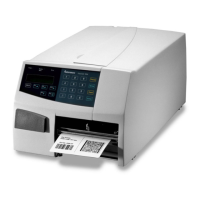Intermec EasyCoder PF2i, PF4i, and PF4i Compact Industrial—Service Manual 133
Chapter 12—Power Supply
Power Factor Control
The power factor control transforms the AC input voltage to 385 VDC
by sensing the shape of the curve of the input voltage and chopping it to
short pulses, where the pulse amplitude follows the shape of the curve. The
booster is protected by two 4A fuses.
Forward Converter
The forward converter transforms 385 VDC to 24 VDC 0-6A. The
24VDC is the bulk voltage and is used for all parts of the printer. Other
voltages needed for internal devices are locally transformed from 24VDC.
Connections
P1 24VDC to CPU board, control lines, and I
2
C bus communication
between PSU and CPU board.
P5 24 VDC to printhead
P6 Ribbon motor
P7 Not used
P8 ISR connector (not used)
P10 Stepper motor
X1 Input voltage 90 to 265 VAC, 45 to 65Hz
Overheating Protection
The power supply unit is fi tted with a sensor that will shut down the
unit in case of overheating (Power Fail Interrupt or PFI) and another
sensor that will warn the main CPU if the power supply is getting hot
(Notify). A Power Fail Interrupt (PFI) signal will warn the logics so
valuable data can be saved before power is lost. Before a print operation is
executed, the Notify signal is checked. If the Notify signal is activated, a
warning is shown in the display and the main CPU will reduce the power
consumption to avoid shutdown by detaining the printing until the Notify
signal is deactivated.
Primary switched power supplies are generally diffi cult to repair. If one
component fails due to aging or overload, a number of other compo-
nents will also break as a consequence. They are hard to troubleshoot,
because the PSU often is “dead” or the fuses blow immediately. It is
also impossible to guarantee the life of a repaired PSU, because com-
ponents may still work but be on the verge of failing. Thus, if a fuse
blows, do not attempt repairing the PSU, but replace the entire unit!

